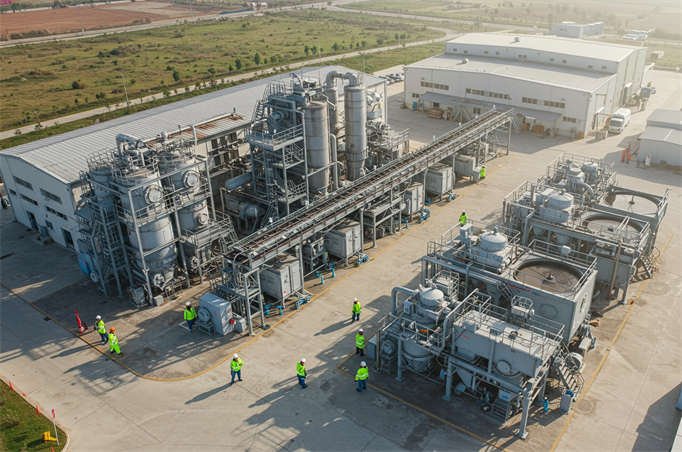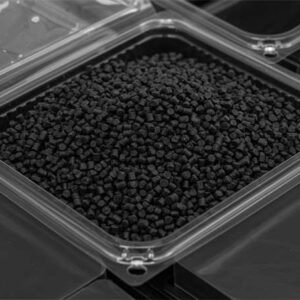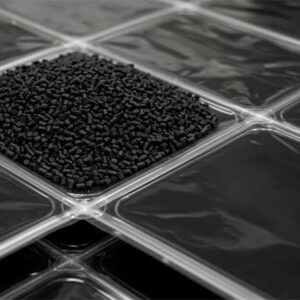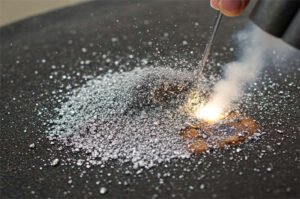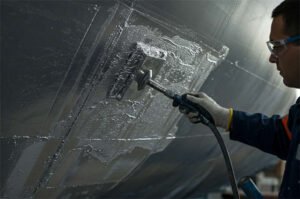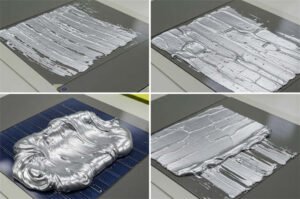When it comes to aluminum paste transport, you must adhere to strict regulations to ensure safety and compliance with the law. Aluminum paste can react with air or water, which poses a danger. For this reason, experts classify it as a hazardous material. Utilizing approved packaging is essential to prevent accidents during aluminum paste transport. Additionally, clear labeling and accurate documentation are crucial in avoiding issues. Safety training provides the necessary knowledge on how to handle aluminum paste safely. Always verify the regulations before you transport or store aluminum paste.
主なポイント
- Always use approved containers to move aluminum paste. This stops leaks and keeps the paste safe.
- Follow strict rules for labeling and paperwork. Correct labels help emergency workers know what to do if there is an accident.
- Wear safety gear like gloves, goggles, and masks when you handle aluminum paste. This keeps you healthy and safe.
- Keep up with transport rules. Rules can change, so look for new guidelines before you ship aluminum paste.
Hazards
Physical & Chemical Risks
It is important to know the risks before you handle aluminum paste. This material can react with water and air. If aluminum paste touches moisture, it can make hydrogen gas. Hydrogen gas can catch fire very easily. If you do not store aluminum paste the right way, it can be dangerous. You should always keep the paste in closed containers. Always check for leaks or damage before moving any container.
ヒント: Always look for dents or rust on containers before aluminum paste transport.
Fire & Explosion
Aluminum paste can start a fire very easily. Even a tiny spark can make a fire if hydrogen gas is around. You must keep the paste away from flames, sparks, or hot things. Only use explosion-proof equipment when working with aluminum paste. Never use tools that make static electricity.
- Keep aluminum paste in cool and dry places.
- Do not stack containers near anything hot.
- Make sure to use grounding during aluminum paste transport.
Health & Environment
You need to protect yourself and nature during aluminum paste transport. Breathing aluminum dust can bother your lungs and eyes. Always wear gloves, goggles, and a mask when you touch the paste. If you spill aluminum paste, clean it up fast. Do not let it go into drains or dirt.
注記: Cleaning up quickly helps keep animals and water safe.
Aluminum Paste Transport Regulations
International Rules
When you move aluminum paste between countries, you must follow strict rules. Many places use the same rules to keep people and nature safe. These rules tell you how to pack, label, and ship aluminum paste transport. Here are some important international rules you should know:
- The International Civil Aviation Organization’s Technical Instructions control air shipments.
- The International Maritime Dangerous Goods Code sets rules for shipping by sea.
- Transport Canada’s Transportation of Dangerous Goods Regulations guide shipments in Canada.
- The International Atomic Energy Agency Regulations help in some cases.
ヒント: Always check the newest version of these codes before planning aluminum paste transport. Rules can change, so you need to stay updated.
U.S. DOT & Local
If you move aluminum paste in the United States, you must follow Department of Transportation rules. The DOT uses Hazardous Materials Regulations to control shipping, handling, and storage. These rules tell you how to package, label, and document aluminum paste transport. Some states and cities have extra rules, so always check local laws before shipping.
You cannot carry aluminum paste on buses or taxis. Only trained workers can handle and move it. The DOT can inspect your shipment at any time. If you break the rules, you might get fines or other penalties.
Alert: Never skip training. The law says you must train anyone who handles or ships aluminum paste.
Classification
You need to know how experts classify aluminum paste before shipping. Aluminum paste is a “dangerous good” or “hazardous material.” The United Nations gives each dangerous good a special number. For aluminum paste, you will often see UN 1396 or UN 1398.
You must use the right classification on all paperwork and labels. This helps emergency workers know what to do if there is an accident. You also need the correct placards on your vehicle. Using the wrong classification puts everyone at risk.
注記: Always double-check the UN number and hazard class before starting aluminum paste transport. Mistakes can cause delays or fines.
Packaging & Labeling
Containers
You have to use approved containers for safe aluminum paste transport. These containers stop leaks and spills. They also keep out dirt and water. Always pick containers that meet safety rules. Many companies use aluminum containers. These are light and strong. They do not rust, so they protect chemicals from moisture.
- Aluminum containers are strong and not heavy.
- They do not rust, so water and air cannot get in.
- Companies make these containers to follow safety rules.
Try to use the original shipping container if you can. Make sure each container is sealed tight. This keeps out dirt and water. Before loading, check for dents, rust, or damage. Use soft padding and blocks to stop bumps during travel. Close all openings and use humidity checks if needed. If you see damage, do not use that container.
ヒント: Keep containers closed when not using them. This stops spills and keeps the paste safe.
Labeling
You must label every shipment the right way. Labels tell workers and helpers what is inside. You have to follow both world and U.S. rules for labels. Each label must be clear and easy to see.
| Requirement | 説明 |
|---|---|
| Emergency Response Information | You must add emergency details as the law says. |
| Training Requirements | Workers need training in world shipping rules. |
| Security Requirements | Follow security rules as the law says. |
| Incident Reporting | Report any problems in the U.S. as needed. |
| Export Packaging Requirements | Follow the rules for export packaging. |
| Reuse and Remanufacture | Follow the rules for using containers again. |
| Registration Requirements | Register your shipment as the law says. |
You also need placards on vehicles with アルミペースト. Placards warn others about the hazardous material. Always check the UN number and hazard class on every label and placard.
Alert: Never ship アルミペースト without the right labels and placards. Wrong or missing labels can cause fines and delays.
Documentation
You need the right papers for every アルミペースト shipment. Papers help track the material and show you follow the law. Always keep these papers with the shipment. Give copies to anyone who handles the paste.
| Requirement | 説明 |
|---|---|
| Hazardous Waste Manifest | Make a manifest if the アルミペースト is hazardous waste. |
| One-time Written Notice | Send a notice to each place getting the waste if it needs treatment first. |
You must also have shipping papers with the UN number, hazard class, and emergency contact. Keep all papers up to date and store them safely during travel.
注記: Good paperwork helps emergency workers act fast if there is an accident.
Handling & Loading
安全対策
You need to follow strict safety steps when you handle アルミペースト. Always check your PPE before you start work. If you see holes or cracks, get new gear right away. Work in a place with good airflow. Open windows or use fans to move dust away from your face. Keep containers closed when you are not using them. This stops dust from getting out. Never eat, drink, or smoke where you use アルミペースト. Clean up spills right away with wet cloths or a vacuum with a HEPA filter.
ヒント: Wear cotton clothes and use metal tools. Do not use plastic tools or synthetic clothes. This helps stop static electricity.
You should use explosion-proof lights, switches, and fans. Make sure all metal containers, shelves, and floors are grounded. This stops static electricity from starting a fire.
ストレージ
Storing アルミペースト the right way keeps you safe. Store it at least 5 meters away from fire. Use safe, tightly closed containers. Keep it away from sunlight and heat. These things can make the paste more dangerous. Always use special tools that do not make sparks.
Here is a table with temperature rules for storage:
| 項目 | 要件説明 |
|---|---|
| 温度 | Keep between 15–40°C. Do not let it drop below 10°C in winter. |
| Winter considerations | Keep above 15°C to stop problems with additives and oxidation. |
| Summer considerations | Keep below 25°C. If it gets above 30°C, the solvent can evaporate and cause damage. |
Alert: Keep the storage area clean and free from things that can burn.
Spill Prevention
You can stop spills by being careful when loading and unloading. Always have a plan for emergencies like spills or leaks. Keep safety gear and spill kits close by. Clean up leaks or spills right away and throw away waste the right way. Use hoses and couplings that fit tight to stop leaks. Dry-disconnects on hoses help stop spills during big deliveries. Make sure all equipment is clean before you move it.
| Procedure | 説明 |
|---|---|
| Contingency Plan | Have a plan for spills, leaks, and fires. |
| Spill Containment | Keep spill kits and absorbent stuff on site. |
| Secure Connections | Use tight hoses and couplings to stop leaks. |
| Immediate Cleanup | Clean up spills right away and throw away waste safely. |
注記: Training helps everyone know what to do if a spill happens during aluminum paste transport.
Emergency Response
Spill Protocols
If a spill happens during aluminum paste transport, you need to act fast. Put on your PPE before you get close to the spill. Never try to clean up a spill in public without the right gear. Keep people away from the area. This keeps everyone safe and stops the spread of dangerous material.
- Always use a strong main container inside another strong container for transport.
- If there is a spill, do not touch it without PPE.
- Block off the area and tell others to stay away.
- Call your Environmental Health and Safety team for help.
- Stay close to give info or help, but do not take risks.
ヒント: Acting fast and using the right gear keeps you and others safe if there is a spill.
Fire Procedures
アルミペースト can catch fire very easily. If you see a fire, use the right extinguisher. Water will not work well on アルミペースト fires. You should use a dry chemical powder extinguisher or a CO2 extinguisher. These can put out the fire quickly and safely.
- Use dry chemical powder extinguishers.
- Use CO2 extinguishers.
- Do not use water because it may not stop the fire.
Alert: Always know where your fire extinguishers are before you start aluminum paste transport.
Reporting
After a spill or fire, you must report it right away. Tell your boss and the EHS team as soon as you can. Give clear details about what happened, where it happened, and what you did. Good reporting helps your company learn and get better at safety.
| Step | What You Should Do |
|---|---|
| Notify | Tell your boss and EHS right away. |
| Record Details | Write down what happened and when. |
| Follow Up | Help with any review or investigation. |
注記: Fast and honest reporting helps everyone stay safe and follow the law.
避けるべき間違い
Packaging Errors
You have to pick the right container for アルミペースト. Some people use containers that are not safe enough. This can cause leaks or spills. Always look for damage before using any container. If you see dents, rust, or cracks, get a new one. Do not use old containers unless they are clean and approved for hazardous materials.
- Only use containers with tight lids.
- Stay away from plastic or other materials that can react with アルミペースト.
- Check the labels to make sure they match what is inside.
ヒント: Try to keep アルミペースト in its original shipping container if you can. This helps stop accidents and keeps you following the rules.
Documentation Issues
You need to keep your paperwork correct and current. Some people forget to put the UN number or hazard class on shipping papers. This can cause delays or fines. Always check every paper before you ship. Make sure you have emergency contact info and the right hazard labels.
| Common Documentation Mistakes | How to Fix Them |
|---|---|
| Missing UN number | Add the correct UN number |
| Wrong hazard class | Check and update hazard class |
| No emergency contact | Include emergency phone number |
| Outdated paperwork | Review and update all documents |
Alert: If your paperwork is not complete, your shipment can be stopped and people can be put in danger. Always check your documents before you ship アルミペースト.
Handling Mistakes
You must follow safety steps when working with アルミペースト. Some people forget to wear gloves or masks. This can hurt your health. Always use personal protective equipment (PPE). Never eat or drink near アルミペースト. Clean up spills right away and keep your work area neat.
- Wear gloves, goggles, and a mask.
- Use tools and equipment that are explosion-proof.
- Keep containers closed when you are not using them.
注記: Good handling keeps you safe and helps protect nature. Training helps you avoid mistakes and act fast if something goes wrong.
You help keep aluminum paste transport safe. Always use the newest rules and the right containers. Check your labels and papers before each shipment. Keep safety gear nearby in case of emergencies. Learn about new safety tips and practice often. Putting safety first keeps you and others safe.
よくあるご質問
What personal protective equipment do you need for aluminum paste transport?
You need to wear gloves, goggles, and a mask. Pick cotton clothes and use metal tools. Explosion-proof gear helps keep you safe. Always check your safety gear before you begin.
Can you transport aluminum paste in a regular car or passenger vehicle?
No, you cannot use a normal car or van. Only special vehicles and trained drivers can move aluminum paste. This rule helps stop accidents and keeps people safe.
How do you know if your container is approved for aluminum paste?
Check for safety labels and look for any damage. Approved containers follow DOT or world safety rules. Try to use the original shipping container if you can.
What should you do if aluminum paste spills during transport?
Move quickly. Put on your PPE. Keep people away from the spill. Use a spill kit to clean up. Call your safety team for help. Report the spill right away.

